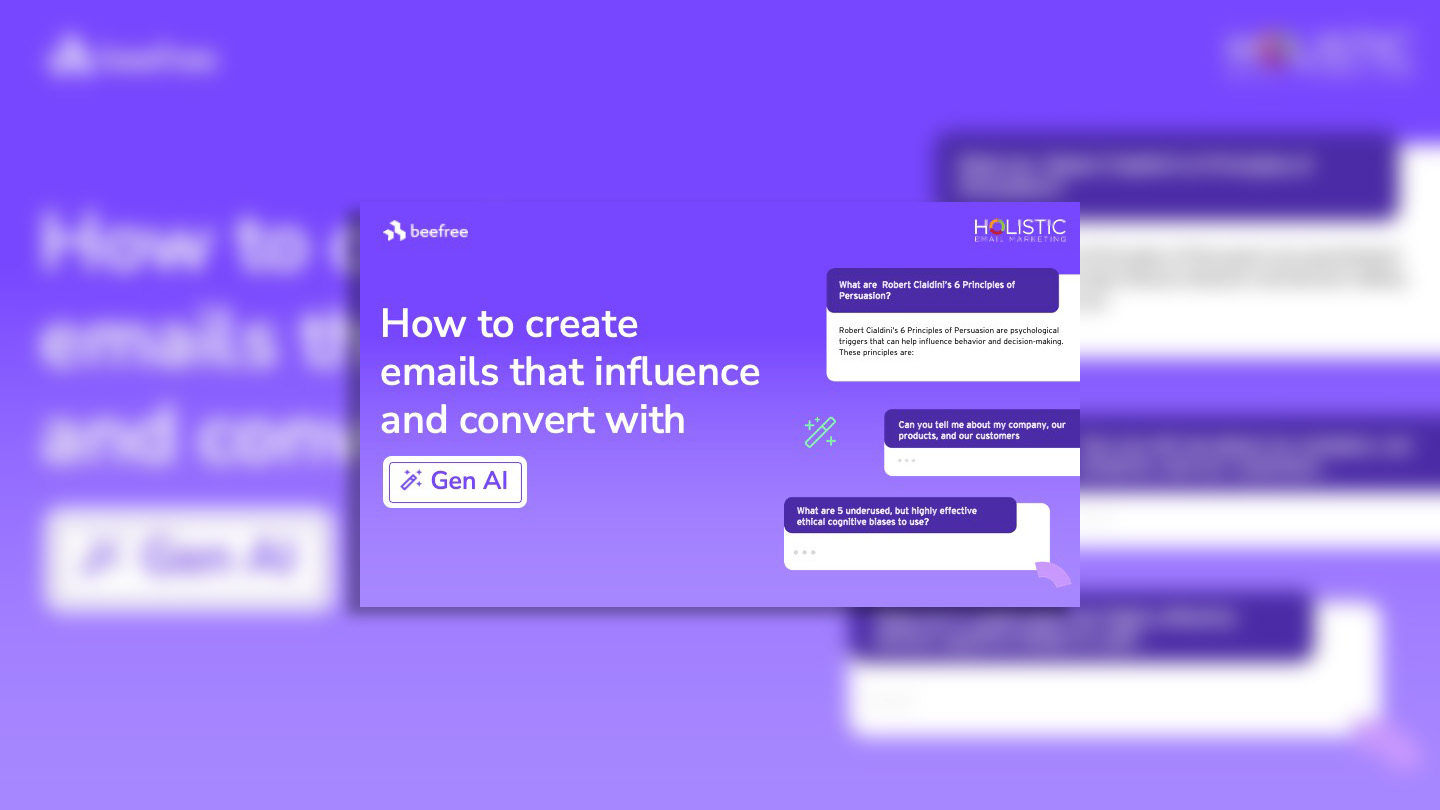How to Create Emails that Influence and Convert with GenAI by Your Side
How can marketers craft emails that stand out and truly engage their recipients? In Beefree’s webinar, How to Create Emails that Influence and Convert with GenAI by Your Side, Kath Pay provided a hands-on look at how marketers can harness AI to craft emails that not only influence but ethically guide customers toward making purchase decisions.
Key Themes
1. Behavioral Science and Persuasion Principles
Kath kicked off the webinar by delving into behavioral science, particularly persuasion principles drawn from Robert Cialdini’s six principles of persuasion. As Kath explained, AI tools can help integrate principles into email copy, guiding users to make choices aligned with their preferences.
“Think of AI as an eager intern,” Kath advised, “who needs clear guidance but can deliver amazing results once primed properly.” This human approach to AI—a theme revisited throughout the discussion—stressed the importance of directing AI with prompts that encourage ethical persuasion.
2. Using Cognitive Biases to Drive Engagement
Building on persuasion principles, Kath introduced cognitive biases as another powerful tool to engage audiences. One such example was the mere exposure effect, which suggests that familiarity breeds preference. Kath demonstrated how this could translate to email marketing by crafting copy that subtly emphasizes familiar elements like popular products or well-loved categories.
“It’s not about tricking people into buying,” Kath clarified, “it’s about helping them make choices that align with their needs by presenting information in a familiar and accessible way.”
3. Tailoring Emails for Different Buyer Modalities
Another crucial takeaway was the need to address multiple buyer personas in a single email. Kath referenced the four buyer modalities outlined by Jeffrey and Bryan Eisenberg in “Waiting for Your Cat to Bark”: spontaneous, methodical, competitive, and humanistic buyers. She noted that by incorporating appeals to each modality, marketers can craft emails that feel personal to a broad audience without needing individualized campaigns.
4. Ethical Considerations in AI-Generated Content
As Kath stressed, AI marketing comes with a responsibility. “AI can produce persuasive content, but it’s up to us as marketers to ensure it’s ethical and serves the customer,” she noted. Kath emphasized transparency and respect for users, urging marketers to avoid tactics that might feel manipulative or overly aggressive. Instead, she advised using AI to help customers make informed decisions in ways that align with their genuine interests.
One pro tip from Kath: Don’t overuse any one persuasion tactic, such as scarcity. “If you lean on scarcity too often, customers begin to see through it, and it loses its impact,” she noted. “Use each principle thoughtfully and selectively.”
Practical Steps for Effective AI Prompts
Kath shared practical insights for working effectively with AI tools, particularly BeeFree’s AI Assistant:
- Priming the AI: Start each session by defining your brand’s values, tone, and objectives. This helps the AI align with your style.
- Sequential Prompting: Kath recommends “prompt stacking,” where you build up prompts incrementally, rather than overwhelming the AI with a complex request all at once.
- Encourage AI Questions: “Ask the AI to ask you questions,” she suggested. This can help refine the AI’s understanding and ensures it’s fully prepared to write copy that matches your intent.
- Blend and Refine: Once the AI delivers options, blend elements from various drafts to create a cohesive final product. “AI gives you a draft, but your expertise is needed to make it impactful,” Kath explained.
Kath also shared examples of testing different AI-generated versions, such as running subject lines that use “scarcity” against those using “reciprocity,” helping brands identify what resonates most with their audiences. She emphasized the importance of A/B testing to validate what truly works with your audience, noting, “AI is a powerful tool, but data-backed insights make it effective.”
Embrace AI as an Extension of Your Strategy
Toward the end of the session, Kath distilled her insights into three guiding principles for integrating AI into email marketing:
- You’re the Director: Use AI as an assistant, but remember that you’re directing the customer’s journey. The AI serves to enhance your strategy, not replace it.
- Balance with Human Expertise: AI can help create compelling content, but your human insight ensures it resonates.
- Test, Learn, and Adapt: Constant testing and adaptation are essential to finding what works. By learning from each campaign, you can make AI-driven marketing a robust part of your strategy.
Kath’s message was clear: AI can be a game-changer, but its real power comes when marketers direct, refine, and guide it. This human-centric approach not only leads to effective campaigns but also builds trust with subscribers.
Don’t miss out on the full insights and techniques shared by Kath Pay in the full webinar, How to Create Emails that Influence and Convert with GenAI by Your Side, available to watch on demand through BeeFree’s platform.
Want to take your email marketing to the next level with behavioral science and GenAI? Whether you’re looking to integrate AI-driven techniques or enhance your testing strategy, there’s no better time to start.
Contact Holistic Email Marketing to learn more about our tailored services in holistic testing, behavioral science, and GenAI solutions. Our experts are here to help you unlock powerful insights that drive real engagement. Get in touch today!



